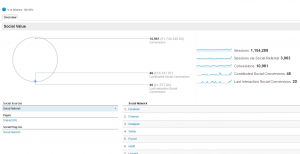
 We all now understand that social media marketing without a clear strategy is dangerous and I am amazed at how many big well-known brands still don’t really have a clear strategy. Yes they do great content and some of it sticks but they don’t actually know why they do it other than their competitors are doing it so they better get organised. In the last twelve months I must have written twenty or so social media strategies and every single one starts the same, with an audit, to take a clear benchmark. To gauge the effectiveness of your social media marketing, it’s necessary to carry out a proper audit on your social media channels from time to time. Although for many, the word audit is enough to cause a wince – those business owners out there will know what I am referring too. However, it’s completely essential if you want to make sure your social media marketing is as effective as it can be. Besides, it’s nowhere near as grim as the title suggests. If you want to gain the highest possible return on investment from social media, then you need an audit to see where you stand as of today – to create a clear benchmark. So with that in mind here’s a brief guide I’ve put together on the key elements you require to carry out for an accurate audit: STARTING OUT 1. WORK OUT WHAT YOUR GOALS ARE The starting point, before you begin the audit, is to clarify what your goals are. Do you want to improve web traffic, online conversions, increase followers, shares or just improve all round? For most people I meet it’s usually a combination of all of these things. Setting these out clearly will help guide the audit throughout. For those looking for a general walkthrough for their first audit, Hootsuite has a great beginner’s template. 2. IDENTIFY YOUR COMPETITORS It’s 2016 and social media marketing is not unique or new anymore – hell everyone now thinks there an expert. Everyone is doing it – we all have phones. Crucially, this means that all your competitors are probably doing it, and you can be pretty sure they’ll have a social presence if they don’t then great you are well ahead already. A useful first step is to identify how you’re competitors, or your client’s competitors are doing and how they are performing week on week. Obviously the aim is to be the best and most effective, but if a competitor is currently top dog, it’s important to identify what they are doing well and to learn from it. Similarly, if someone is doing something badly – learn from that too – it’s a case of following best practice. 3. IDENTIFY YOUR STRENGTHS AND WEAKNESSES In the same vein that you must analyse what your competitors have done well, you must take note of elements of your own work that showed promise. Any post or content item that gained a higher amount of shares or better conversion stats than the average post should be noted, no matter how small the percentage increase – think of it like mathematics a 0.25% increase can have a big impact just ask the Mark Carney. An audit is about checking on your progress and improving performance, so if there’s any hint of effective content from yourself, or examples that are not effective- it’s essential to add them to the report. You’re aiming to get the complete picture. You don’t have to fork out for expensive tools to analyse your channels either – just use the insights section of each channel they all have them. Because they all want you to spend money on paid reach. 4. WHAT HAVE YOU DONE SO FAR? Dig out the complete history of your brand’s social media footprint. This is particularly prominent if this is the first major audit you are carrying out on your social. You can’t expect to improve if you don’t know the complete history of your brand’s social media marketing. MEASURING 5. LOCATE ALL YOUR SOCIAL MEDIA PROFILES I am currently working with a University in the UK and I have recently added more than 200 profiles to a tool I am using for this element – so I feel your pain if you have a lot. It’s crucial to lay out all your social media profiles individually, so you can report on them all in detail and compare and contrast performance of each one. If working for an agency on behalf of a client, be sure to search high and wide for accounts on all platforms. That dormant Pinterest account with 12 followers that has been set up by a prior agency may be hard to find- but if it’s still out there, then it’s representing the brand! 6. PICK THE RIGHT TOOLS Analytics are a marketer’s best friend, and luckily social media consists of them from the ground up. With so much valuable data to be analysed, your audit needs to be carried out with the right tools. The industry often goes for expensive solutions like the ones I use such as Radian6, Sysomos or the more simplistic-yet still powerful content marketing software like BuzzSumo or SEMrush. Crucially, you need to pick tools that are going to be valuable for your business and- tying back to the first point- what your goals actually are. If you want to identify popular content, you’ll need different software than if you were looking to improve on sales/conversions. Different problems require different tools and if you are not careful you could end up having too many that cross over. 7. FIND THE BEST WAY TO MEASURE As mentioned before, every audit has specific goals. You need to find the best form of measurements for the items you’re seeking to improve. Most of it is likely to be numerical, yet reporting on elements of quality content sometimes demands more than figures. I often find that if you examine each channel carefully, you can determine which has the best dwell time spent on the website, which has the lowest bounce rate, which social follower views the most amount of pages. I had a rather large retail client recently that told me Pinterest wasn’t in their strategy – however when we examined their data we found that a Pinterest user was spending five times longer on their store than any other social follower. Needless to say Pinterest is now a channel of importance. In truth numerical figures usually break down into three main categories: Conversation rate, amplification rate, and applause rate- more on that here. 8. TURN THESE INTO REPORTS Yes, there’s going to be spreadsheets, yet you’ll be thankful once you have an extensive report of your social’s strengths weaknesses and everything in between. In a digital age, we have an opportunity to reflect on customer behaviour like never before, and an audit of this kind is a brilliant example of just how powerful analytics can be. If you do decide to use a paid for platform some of the visualisation graphs can be very powerful at illustrating when something is doing well and when something isn’t doing so well. 9. FIND THE MOST SUCCESFULL CONTENT A final point- going forward in the future, you’ll want to know what your most successful content is. Now this may not in fact even be in your industry/field, there may be a wider trend, which could be of value to the way you shape your social strategy. For analysing popular content, I use a number of tools such as Google Analytics and Ruzzit, which tells you everything you need to know about the most shared content you choose based on the usual series of keywords. It can look at domain to outlet; style to word length! All of this will help give you an idea of the direction to head in your social media content in the future.
We all now understand that social media marketing without a clear strategy is dangerous and I am amazed at how many big well-known brands still don’t really have a clear strategy. Yes they do great content and some of it sticks but they don’t actually know why they do it other than their competitors are doing it so they better get organised. In the last twelve months I must have written twenty or so social media strategies and every single one starts the same, with an audit, to take a clear benchmark. To gauge the effectiveness of your social media marketing, it’s necessary to carry out a proper audit on your social media channels from time to time. Although for many, the word audit is enough to cause a wince – those business owners out there will know what I am referring too. However, it’s completely essential if you want to make sure your social media marketing is as effective as it can be. Besides, it’s nowhere near as grim as the title suggests. If you want to gain the highest possible return on investment from social media, then you need an audit to see where you stand as of today – to create a clear benchmark. So with that in mind here’s a brief guide I’ve put together on the key elements you require to carry out for an accurate audit: STARTING OUT 1. WORK OUT WHAT YOUR GOALS ARE The starting point, before you begin the audit, is to clarify what your goals are. Do you want to improve web traffic, online conversions, increase followers, shares or just improve all round? For most people I meet it’s usually a combination of all of these things. Setting these out clearly will help guide the audit throughout. For those looking for a general walkthrough for their first audit, Hootsuite has a great beginner’s template. 2. IDENTIFY YOUR COMPETITORS It’s 2016 and social media marketing is not unique or new anymore – hell everyone now thinks there an expert. Everyone is doing it – we all have phones. Crucially, this means that all your competitors are probably doing it, and you can be pretty sure they’ll have a social presence if they don’t then great you are well ahead already. A useful first step is to identify how you’re competitors, or your client’s competitors are doing and how they are performing week on week. Obviously the aim is to be the best and most effective, but if a competitor is currently top dog, it’s important to identify what they are doing well and to learn from it. Similarly, if someone is doing something badly – learn from that too – it’s a case of following best practice. 3. IDENTIFY YOUR STRENGTHS AND WEAKNESSES In the same vein that you must analyse what your competitors have done well, you must take note of elements of your own work that showed promise. Any post or content item that gained a higher amount of shares or better conversion stats than the average post should be noted, no matter how small the percentage increase – think of it like mathematics a 0.25% increase can have a big impact just ask the Mark Carney. An audit is about checking on your progress and improving performance, so if there’s any hint of effective content from yourself, or examples that are not effective- it’s essential to add them to the report. You’re aiming to get the complete picture. You don’t have to fork out for expensive tools to analyse your channels either – just use the insights section of each channel they all have them. Because they all want you to spend money on paid reach. 4. WHAT HAVE YOU DONE SO FAR? Dig out the complete history of your brand’s social media footprint. This is particularly prominent if this is the first major audit you are carrying out on your social. You can’t expect to improve if you don’t know the complete history of your brand’s social media marketing. MEASURING 5. LOCATE ALL YOUR SOCIAL MEDIA PROFILES I am currently working with a University in the UK and I have recently added more than 200 profiles to a tool I am using for this element – so I feel your pain if you have a lot. It’s crucial to lay out all your social media profiles individually, so you can report on them all in detail and compare and contrast performance of each one. If working for an agency on behalf of a client, be sure to search high and wide for accounts on all platforms. That dormant Pinterest account with 12 followers that has been set up by a prior agency may be hard to find- but if it’s still out there, then it’s representing the brand! 6. PICK THE RIGHT TOOLS Analytics are a marketer’s best friend, and luckily social media consists of them from the ground up. With so much valuable data to be analysed, your audit needs to be carried out with the right tools. The industry often goes for expensive solutions like the ones I use such as Radian6, Sysomos or the more simplistic-yet still powerful content marketing software like BuzzSumo or SEMrush. Crucially, you need to pick tools that are going to be valuable for your business and- tying back to the first point- what your goals actually are. If you want to identify popular content, you’ll need different software than if you were looking to improve on sales/conversions. Different problems require different tools and if you are not careful you could end up having too many that cross over. 7. FIND THE BEST WAY TO MEASURE As mentioned before, every audit has specific goals. You need to find the best form of measurements for the items you’re seeking to improve. Most of it is likely to be numerical, yet reporting on elements of quality content sometimes demands more than figures. I often find that if you examine each channel carefully, you can determine which has the best dwell time spent on the website, which has the lowest bounce rate, which social follower views the most amount of pages. I had a rather large retail client recently that told me Pinterest wasn’t in their strategy – however when we examined their data we found that a Pinterest user was spending five times longer on their store than any other social follower. Needless to say Pinterest is now a channel of importance. In truth numerical figures usually break down into three main categories: Conversation rate, amplification rate, and applause rate- more on that here. 8. TURN THESE INTO REPORTS Yes, there’s going to be spreadsheets, yet you’ll be thankful once you have an extensive report of your social’s strengths weaknesses and everything in between. In a digital age, we have an opportunity to reflect on customer behaviour like never before, and an audit of this kind is a brilliant example of just how powerful analytics can be. If you do decide to use a paid for platform some of the visualisation graphs can be very powerful at illustrating when something is doing well and when something isn’t doing so well. 9. FIND THE MOST SUCCESFULL CONTENT A final point- going forward in the future, you’ll want to know what your most successful content is. Now this may not in fact even be in your industry/field, there may be a wider trend, which could be of value to the way you shape your social strategy. For analysing popular content, I use a number of tools such as Google Analytics and Ruzzit, which tells you everything you need to know about the most shared content you choose based on the usual series of keywords. It can look at domain to outlet; style to word length! All of this will help give you an idea of the direction to head in your social media content in the future.
@chris_norton Great post, but you missed one out. 10) An audit must be independent and done externally @shelholtz has opinions on this
— Stuart Bruce (@stuartbruce) September 16, 2016
@stuartbruce @shelholtz I didn’t want to feel I was selling too hard. I will add your tweet as an embed as that is a good point.
— chris_norton (@chris_norton) September 16, 2016
Chris Norton is the founder of Prohibition and an award winning communications consultant with more than twenty years’ experience. He was a lecturer at Leeds Beckett University and has had a varied PR career having worked both in-house and in a number of large consultancies. He is an Integrated PR and social media blogger and writes on a wide variety of blogs across a huge amount of topics from digital marketing, social media marketing right through to technology and crisis management.


